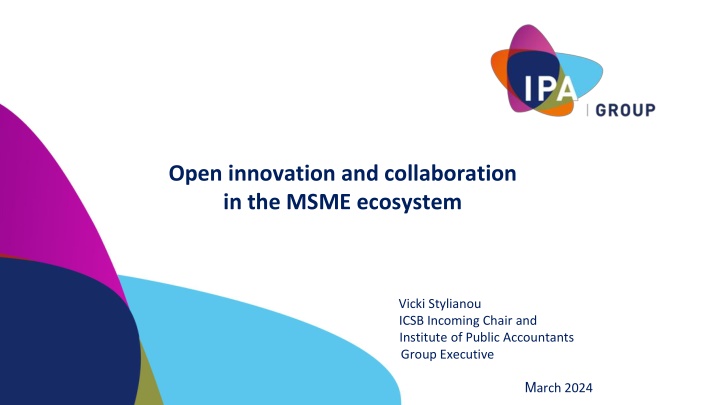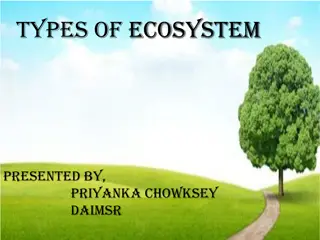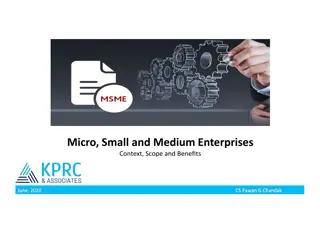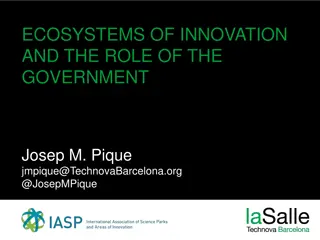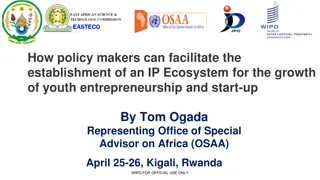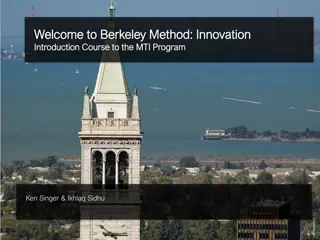Open innovation and collaboration in the MSME ecosystem
MSMEs face challenges like limited resources and market access but can thrive by embracing open innovation and collaboration strategies. These approaches involve leveraging external ideas and working with stakeholders to drive innovation and achieve common goals. In contrast, closed innovation relies on internal resources for innovation. By adopting open practices, MSMEs can overcome obstacles and succeed in today's economy.
Download Presentation

Please find below an Image/Link to download the presentation.
The content on the website is provided AS IS for your information and personal use only. It may not be sold, licensed, or shared on other websites without obtaining consent from the author.If you encounter any issues during the download, it is possible that the publisher has removed the file from their server.
You are allowed to download the files provided on this website for personal or commercial use, subject to the condition that they are used lawfully. All files are the property of their respective owners.
The content on the website is provided AS IS for your information and personal use only. It may not be sold, licensed, or shared on other websites without obtaining consent from the author.
E N D
Presentation Transcript
Open innovation and collaboration in the MSME ecosystem Vicki Stylianou ICSB Incoming Chair and Institute of Public Accountants Group Executive March 2024
Overview What is open innovation and collaboration? How do you implement open innovation and collaboration? What are the benefits of open innovation and collaboration? Who should MSMEs innovate and collaborate with? All of this information is relevant to all MSMEs, no matter the industry sector or the stage of development of the business.
Introduction MSMEs play a vital role in driving economic growth, creating employment opportunities, and fostering innovation. However, they face challenges in terms of limited resources, lack of access to markets, and difficulties in scaling their businesses. Open innovation and collaboration are two strategies that can help MSMEs overcome these challenges and thrive in today s economy.
What is open innovation and what is collaboration?
What is open innovation and what is collaboration? There are many definitions, models, tools, processes etc. Open innovation refers to the practice of leveraging external ideas, technologies, and expertise to drive innovation and create value. It means embracing the exchange and collaboration of ideas beyond the traditional boundaries of an organisation. On the other hand, collaboration involves working together with various stakeholders, such as other businesses, government agencies, research institutions, and non-profit organizations, to achieve common goals. Collaboration is usually part of open innovation.
What is closed innovation? Closed innovation, also known as the traditional or traditional closed model, is characterized by a primarily internal focus on research and development and a closed system for innovation. In this approach, companies rely on their internal resources, expertise, and capabilities to generate, develop, and commercialize innovations. The closed innovation model assumes that the organization has the necessary knowledge and capabilities to solve all its innovation challenges internally.
Collaborative problem solving Collaboration brings together individuals with different backgrounds, skills, and experiences. When MSMEs collaborate with external partners, they can collectively tackle complex problems and challenges. The diverse perspectives and expertise of the collaborators can lead to unique solutions and innovative approaches that may not have been possible within the MSME alone. Through collaborative problem-solving, MSMEs can uncover new ideas and concepts that can be translated into innovative products and services.
How do you implement open innovation and collaboration?
The open innovation process Source: itonics
How to facilitate open innovation and collaboration To facilitate open innovation and collaboration in the MSME ecosystem, it is essential to create an enabling environment. This includes: o providing access to funding and financial support; o promoting the exchange of knowledge and best practices; and o fostering a culture of trust and partnership among stakeholders. Governments and policymakers can play a crucial role in creating the necessary infrastructure and frameworks to support open innovation and collaboration.
Checklist for open innovation 1. Define what open innovation means for your organization. What are your goals? What processes will you use? Who will be involved? 2. Explain the objectives of open innovation and how this would help meet business goals. Are you attempting to enter new markets, enhance service or product offerings, reduce the risk and cost of existing innovation, or initiate a diversity of perspectives and ideas? 3. Detail how you will build trust and genuine engagement. How will you contact potential stakeholders and partners? 4. Share examples of successful open innovation projects. Showcase a few of these examples to demonstrate what's possible with open innovation. 5. Outline a step-by-step plan for implementing open innovation. How will you identify ideas from employees, customers, partners, and other stakeholders? How will you evaluate ideas and manage the process? Will your open innovation campaigns be specific or ongoing?
Examples of successful open innovation Netflix was one of the first companies to successfully use open innovation. In the early 2000s, faced with major challenges in its DVD rental business, it launched the Netflix Prize, offering $1 million to anyone who could improve the company s recommendation algorithm by at least 10%. It was won by a team of researchers from AT&T Labs. Other examples are BMW, Porsche and Bosch.
What are the benefits of open innovation and collaboration?
Benefits increased innovation Open innovation enables MSMEs to tap into a vast pool of ideas, knowledge and expertise that may not be available within their own organization. This can lead to innovative solutions, improved products and services, and staying ahead of the competition. By collaborating with external partners, MSMEs can also access new markets, expand their customer base, and create new business opportunities.
Benefits learning and continuous improvement Open innovation and collaboration foster a culture of learning and continuous improvement within the MSME ecosystem. Through interactions with external partners, MSMEs can gain valuable insights, acquire new skills and enhance their capabilities. This not only benefits individual MSMEs but also contributes to the overall growth and development of the ecosystem.
Benefits expanded market reach Collaboration allows MSMEs to tap into the customer base and distribution channels of their partners. By combining resources and networks, MSMEs can reach a larger audience and expand their market presence. This can result in increased sales, revenue growth, and enhanced brand visibility.
Benefits enhanced product quality Open innovation and collaboration enable MSMEs to tap into the expertise and knowledge of their partners in areas such as product design, manufacturing processes, and quality control. By leveraging these resources, MSMEs can improve the quality of their products and services, leading to higher customer satisfaction and loyalty.
Benefits resource efficiency and cost-effectiveness By sharing resources, facilities, and infrastructure, MSMEs can reduce their operational costs and achieve economies of scale. Collaborating on research and development activities allows MSMEs to pool their resources and share the risks associated with innovation.
Benefits faster time to market Through collaboration, MSMEs can leverage the resources and capabilities of their partners to accelerate the product development and launch process. By working together, they can share research and development costs, access specialized facilities, and tap into existing distribution networks. This can help MSMEs bring their products and services to market faster, gaining a competitive advantage.
Benefits access to new technologies Collaborating with external partners can give MSMEs access to new technologies and tools that they may not have the resources to develop on their own. This can help them incorporate cutting-edge technologies into their products and services, keeping them at the forefront of industry trends and customer expectations.
Benefits mitigation of risks Collaboration allows MSMEs to share risks associated with product development, market entry, and innovation. By partnering with other businesses, MSMEs can distribute the risks and costs, making it more manageable for each party involved. This helps MSMEs to take calculated risks and explore new opportunities without bearing the entire burden themselves.
Who should MSMEs choose to innovate and collaborate with and why?
Open innovation with start ups Startups bring agility, disruptive ideas, and novel business models to the open innovation process. Their involvement includes: o Technology and innovation scouting: This helps to identify emerging technologies and innovative business concepts, leveraging the startup ecosystem's dynamism and creativity. Incubation and acceleration programs: Support through incubation or acceleration programs, includes offering resources, mentorship, and funding to nurture growth and innovation potential. Co-creation and collaboration: This process can help to develop new products, services, or solutions, leveraging innovative capabilities and market insights.
Start ups in Fiji potential for growth Source: www.tracxn.com
Open innovation with universities and research institutions Research collaboration: Working together on research projects, exploring new technologies, scientific knowledge, and solving complex challenges. Technology licensing: Academic institutions often hold intellectual property rights resulting from their research activities. Licensing agreements allow companies to access and utilize these technologies for commercial purposes. Talent exchange: Such as internships, joint appointments, or academic-industry partnerships, fostering knowledge exchange and skill development.
Open innovation with customers Customers needs, preferences, and insights provide valuable input for identifying innovation opportunities and developing customer-centric solutions. Customers can contribute by: o Idea generation and product testing: Providing innovative ideas, suggestions, and feedback on existing products or services, leading to improvements or new products or ideas. Co-creation: Collaboration on design and development of customized solutions that meet specific needs and preferences.
Open innovation with suppliers Technology and knowledge transfer: Suppliers share their technological advancements, industry insights, and specialized knowledge, enabling companies to access new ideas and technologies. Co-development: Through collaborative partnerships, suppliers work together with companies to develop new products, processes, or materials, combining their respective expertise. Supply chain innovation: Suppliers offer innovative solutions within the supply chain, such as improved logistics, sustainable practices, or cost-saving initiatives, benefiting the entire ecosystem.
Open innovation with other businesses Complementary and cross-industry businesses: By partnering with these businesses, MSMEs can leverage their expertise, knowledge, resources, market insights and gain access to new ideas. This can involve joint research and development projects, sharing best practices, or even forming strategic alliances. Competitors: Entering into licensing agreements, exchanging intellectual property rights and technologies to access new markets or enhance product offerings.
Open innovation with industry associations, networks and govt Industry associations, networks and govt agencies: These are a great platform for identifying potential businesses for open innovation and collaboration. Conferences like this one are great opportunities to meet like-minded people and explore the potential for mutual benefit. This includes exchanging ideas, experience and knowledge. There are online platforms and communities for open innovation and which facilitate collaboration. Government initiatives and programs offer specialized knowledge, mentorship, and financial support to drive innovation and develop unique products and services.
Conclusion Open innovation and collaboration are powerful strategies that can drive the growth and success of MSMEs in today's competitive business landscape. By embracing these strategies, MSMEs can leverage external resources, tap into new markets, and foster innovation. However, to fully realize the potential of open innovation and collaboration, it is important for all stakeholders to work together and create an environment that promotes and supports these practices. We need to come together to build a thriving MSME ecosystem through open innovation and collaboration. We need ongoing commitment from all stakeholders.
Takeaways Think of your business or a business you know of. Which services, products, challenges or opportunities might benefit from open innovation and collaboration? Who will you join with to innovate and collaborate? Business Assistance Fiji may be able to facilitate businesses to join together to benefit from open innovation and collaboration.
Thank you vicki.stylianou@publicaccountants.org.au LinkedIn: Vicki Stylianou
